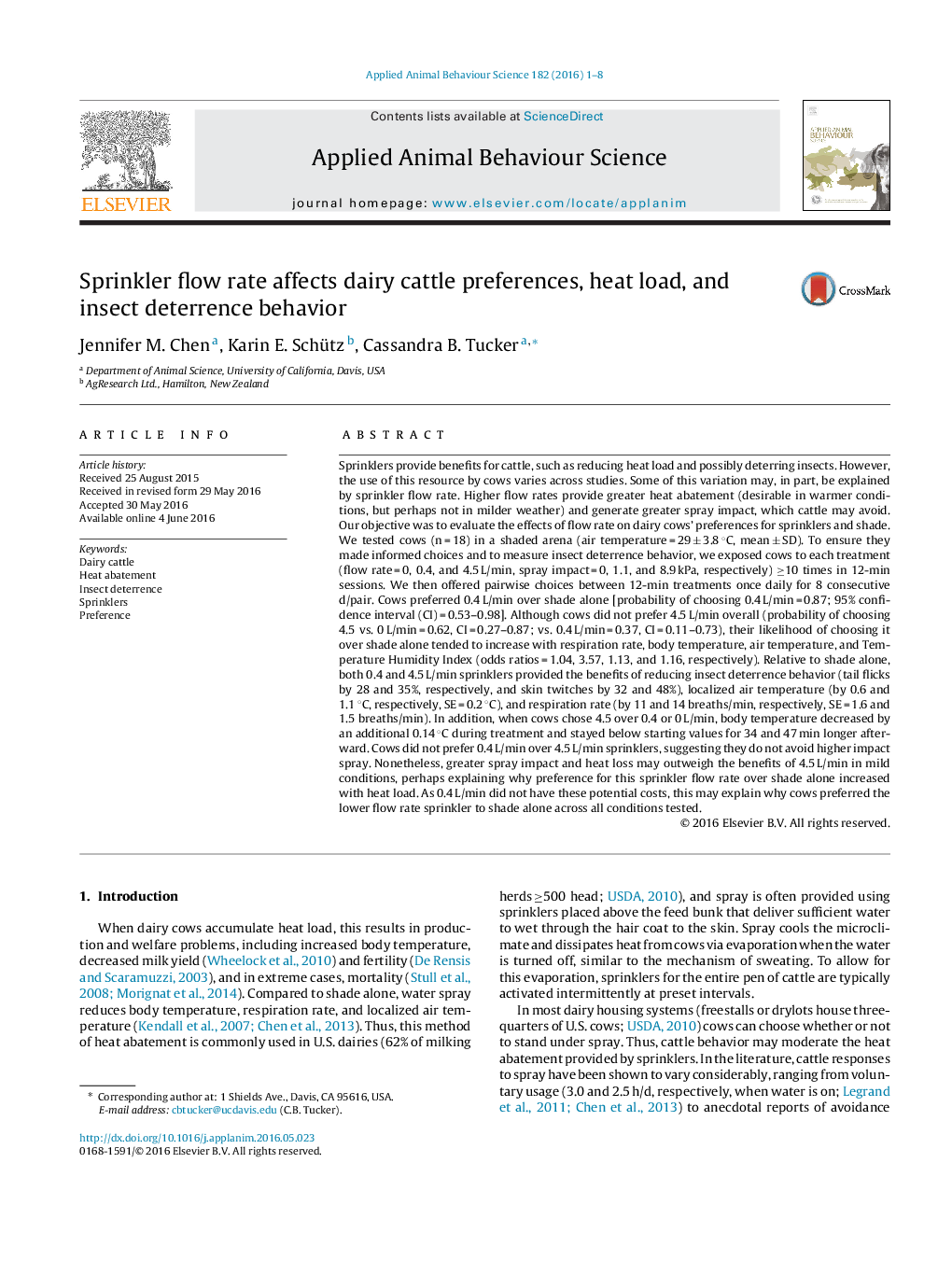| کد مقاله | کد نشریه | سال انتشار | مقاله انگلیسی | نسخه تمام متن |
|---|---|---|---|---|
| 4522328 | 1625324 | 2016 | 8 صفحه PDF | دانلود رایگان |
• Relative to shade alone, cows prefer 0.4 L/min spray overall, 4.5 L/min when warmer.
• Both 0.4 and 4.5 L/min reduce tail flicks and skin twitches relative to shade alone.
• Microclimate temperature decreases as flow rate increases (0, 0.4, 4.5 L/min).
• When cows choose spray, respiration rate is reduced, and more so by 4.5 L/min.
• When cows choose 4.5 L/min, body temperature is reduced in the following hour.
Sprinklers provide benefits for cattle, such as reducing heat load and possibly deterring insects. However, the use of this resource by cows varies across studies. Some of this variation may, in part, be explained by sprinkler flow rate. Higher flow rates provide greater heat abatement (desirable in warmer conditions, but perhaps not in milder weather) and generate greater spray impact, which cattle may avoid. Our objective was to evaluate the effects of flow rate on dairy cows’ preferences for sprinklers and shade. We tested cows (n = 18) in a shaded arena (air temperature = 29 ± 3.8 °C, mean ± SD). To ensure they made informed choices and to measure insect deterrence behavior, we exposed cows to each treatment (flow rate = 0, 0.4, and 4.5 L/min, spray impact = 0, 1.1, and 8.9 kPa, respectively) ≥10 times in 12-min sessions. We then offered pairwise choices between 12-min treatments once daily for 8 consecutive d/pair. Cows preferred 0.4 L/min over shade alone [probability of choosing 0.4 L/min = 0.87; 95% confidence interval (CI) = 0.53–0.98]. Although cows did not prefer 4.5 L/min overall (probability of choosing 4.5 vs. 0 L/min = 0.62, CI = 0.27–0.87; vs. 0.4 L/min = 0.37, CI = 0.11–0.73), their likelihood of choosing it over shade alone tended to increase with respiration rate, body temperature, air temperature, and Temperature Humidity Index (odds ratios = 1.04, 3.57, 1.13, and 1.16, respectively). Relative to shade alone, both 0.4 and 4.5 L/min sprinklers provided the benefits of reducing insect deterrence behavior (tail flicks by 28 and 35%, respectively, and skin twitches by 32 and 48%), localized air temperature (by 0.6 and 1.1 °C, respectively, SE = 0.2 °C), and respiration rate (by 11 and 14 breaths/min, respectively, SE = 1.6 and 1.5 breaths/min). In addition, when cows chose 4.5 over 0.4 or 0 L/min, body temperature decreased by an additional 0.14 °C during treatment and stayed below starting values for 34 and 47 min longer afterward. Cows did not prefer 0.4 L/min over 4.5 L/min sprinklers, suggesting they do not avoid higher impact spray. Nonetheless, greater spray impact and heat loss may outweigh the benefits of 4.5 L/min in mild conditions, perhaps explaining why preference for this sprinkler flow rate over shade alone increased with heat load. As 0.4 L/min did not have these potential costs, this may explain why cows preferred the lower flow rate sprinkler to shade alone across all conditions tested.
Journal: Applied Animal Behaviour Science - Volume 182, September 2016, Pages 1–8
